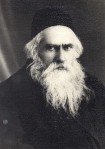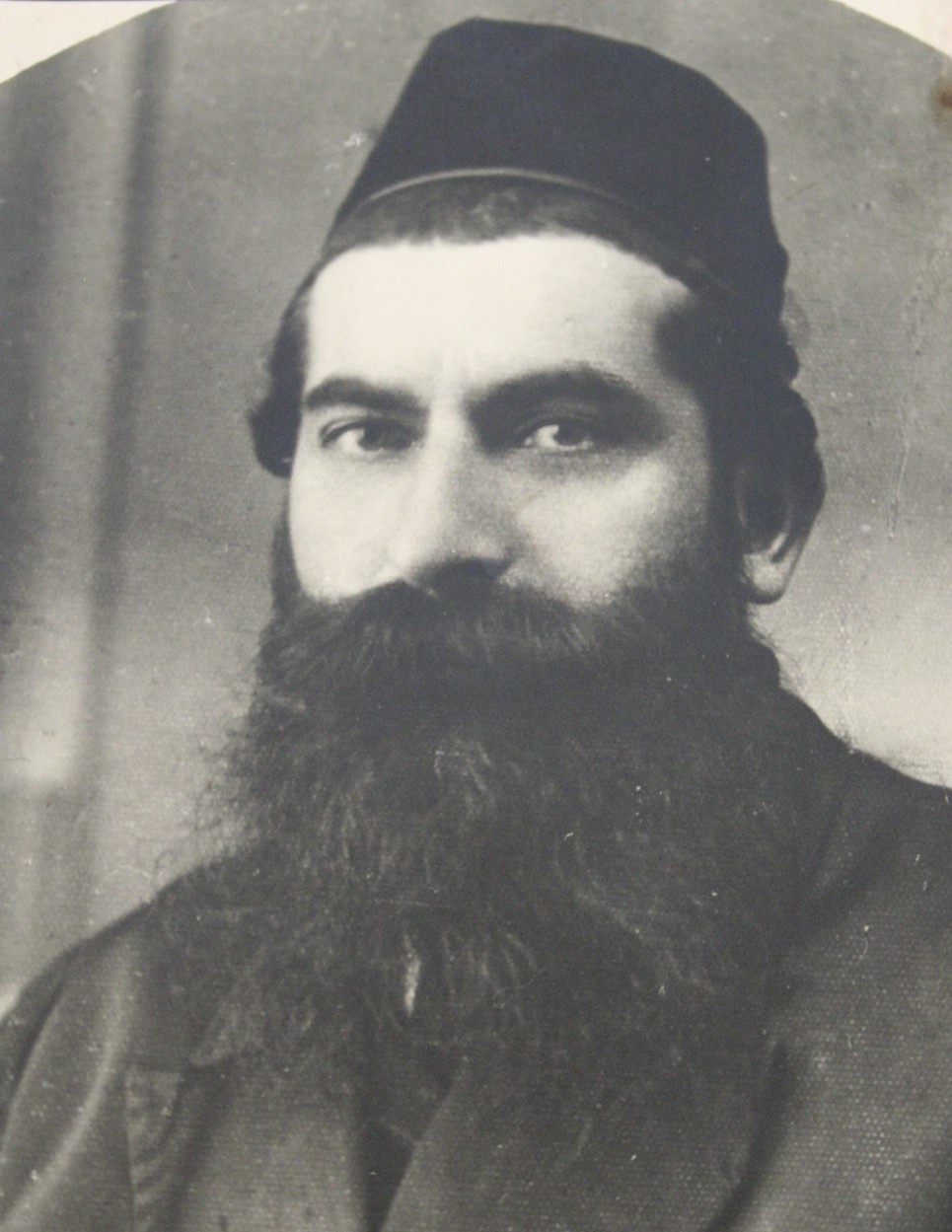Other Names: Skepe, Skempe (Russian,
German) Schemmensee (German, 1942-45)
Location: 52º52 N 19º21'
E
131 km WNW
of Warszawa
26
miles NNW of Płock
Nearby
cities: Lipno, Sierpc
Jewish Life in Skȩpe
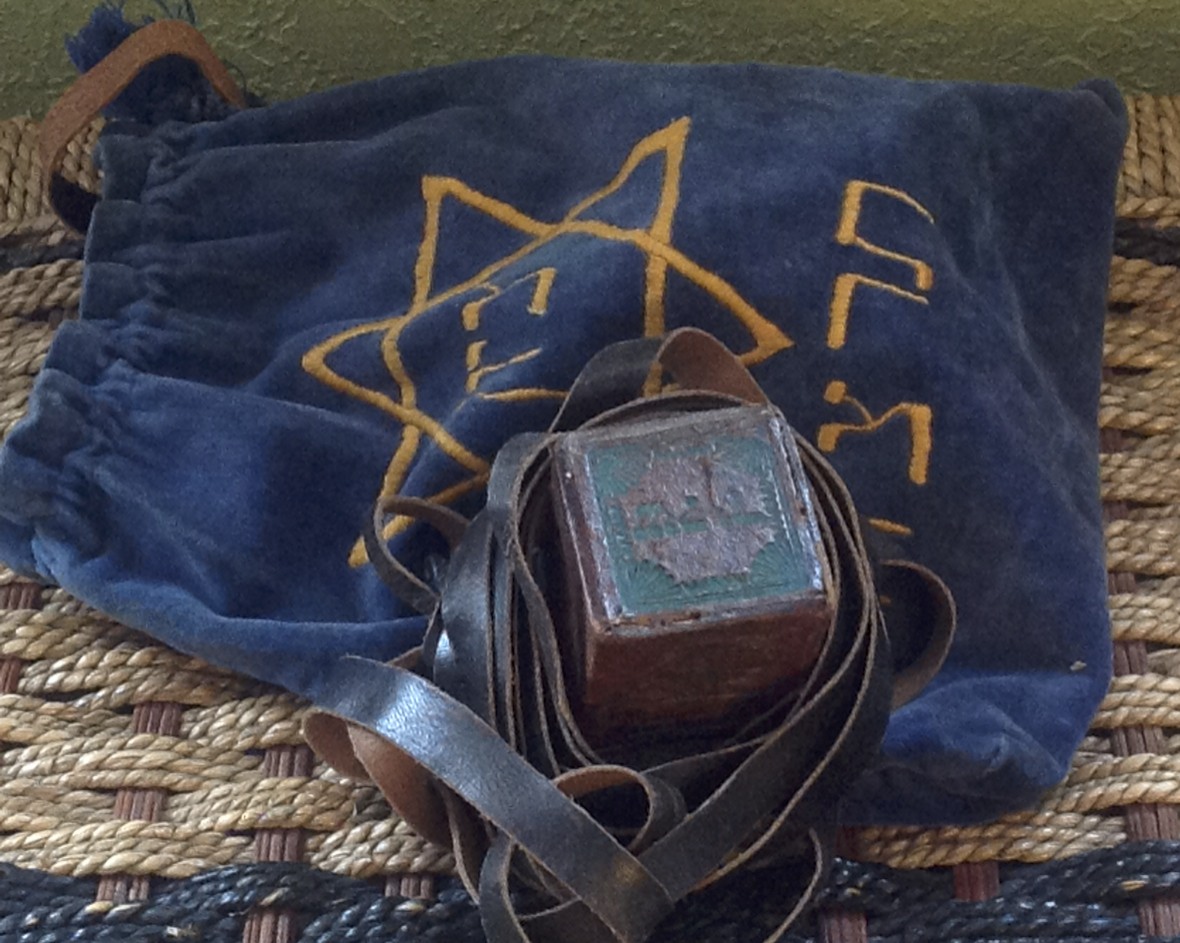
From the Berg Family collection
|
Jewish Families |
Rabbi's
Response to German Invasion |
The Jewish Cemetery |
|
|
|||||||||||||||||||||||||||||||||||||||||||||||||||||||||||||||||||||||||||||||||||||||||||||||||||||||||||||||
Jewish Families of Skȩpe, 1939 As remembered by Rywka Pozmanter
|
List
of Skȩpe's
Inhabitants in 1939 who Paid the Contribution for the
Community
| Surname and Name |
Occupation |
Amount (zloty) |
| Adler
Anszel |
Baker |
180 |
| Adler Chaim |
Merchant |
40 |
| Adler
Josek |
Merchant |
600 |
| Brodacz
Josef |
75 |
|
| Bruszczyński
David |
Butcher |
10 |
| Bursztyn
Abram |
Merchant |
130 |
| Bursztyn
Izrael |
Merchant |
225 |
| Burtke Hana Rywka | 75 |
|
| Burtke Pinkus | Butcher |
10 |
| Cudkiewicz
Abram |
Merchant |
50 |
| Fagot Icek | Merchant |
10 |
| Fagot
Machał |
10 |
|
| Fogel
Lejzor |
Merchant |
40 |
| Goldberg
Binem |
15 |
|
| Goldman
Salomon |
Hairdresser |
10 |
| Goldman
Szaja |
Butcher |
15 |
| Gruza
Aron |
10 |
|
| Gutman
Szaja |
Butcher |
50 |
| Hartbrot
Dawid |
Merchant |
90 |
| Jakubowicz
Szoel |
Merchant |
30 |
| Kohn
Berek |
40 |
|
| Kohn
Josek |
10 |
|
| Kohn
Nuchim |
Clerk |
15 |
| Kurczak
Josek Mechel |
10 |
|
| Nusbaum
Aron |
Merchant |
60 |
| Ogrodowicz
Chiel |
Merchant |
20 |
| Pieta
Aron |
Worker |
10 |
| Pieta
Lejzor |
Merchant |
40 |
| Pisarz
Jakub Baruch |
Merchant |
20 |
| Podrygał
Chiel Majer |
Baker |
10 |
| Podrygał
Szymcha Hercel |
10 |
|
| Pozmanter
Chaim |
Merchant |
20 |
| Pozmanter
Szlama |
Merchant |
175 |
| Rogensztein
Izrael |
Merchant |
15 |
| Rozenwaks
Anszel |
Merchant |
100 |
| Ruda
Gusen |
Leather
Stitcher |
30 |
| Rywanowicz
Jakub |
Merchant |
60 |
| Sarna
Aron |
10 |
|
| Strykowski
Fiszel |
Tailor |
10 |
| Strykowski
Moszek |
Tailor |
60 |
| Szapiro Szulik | Merchant |
60 |
| Szelka
Icek |
Merchant |
10 |
| Szperling Nachman | Merchant |
10 |
| Winczarski
Szmerel |
Merchant |
10 |
| Winkielman
Rywen |
Merchant |
230 |
| Zeszotko
Chaim |
10 |
|
| Żelek
Aron Fałek |
10 |
|
| Żychliński
Abram |
60 |
Source: APB, UWPT, file no.
4492
Virtual Shtetl
The Jewish Cemetery of Skępe
Virtual Shtetl
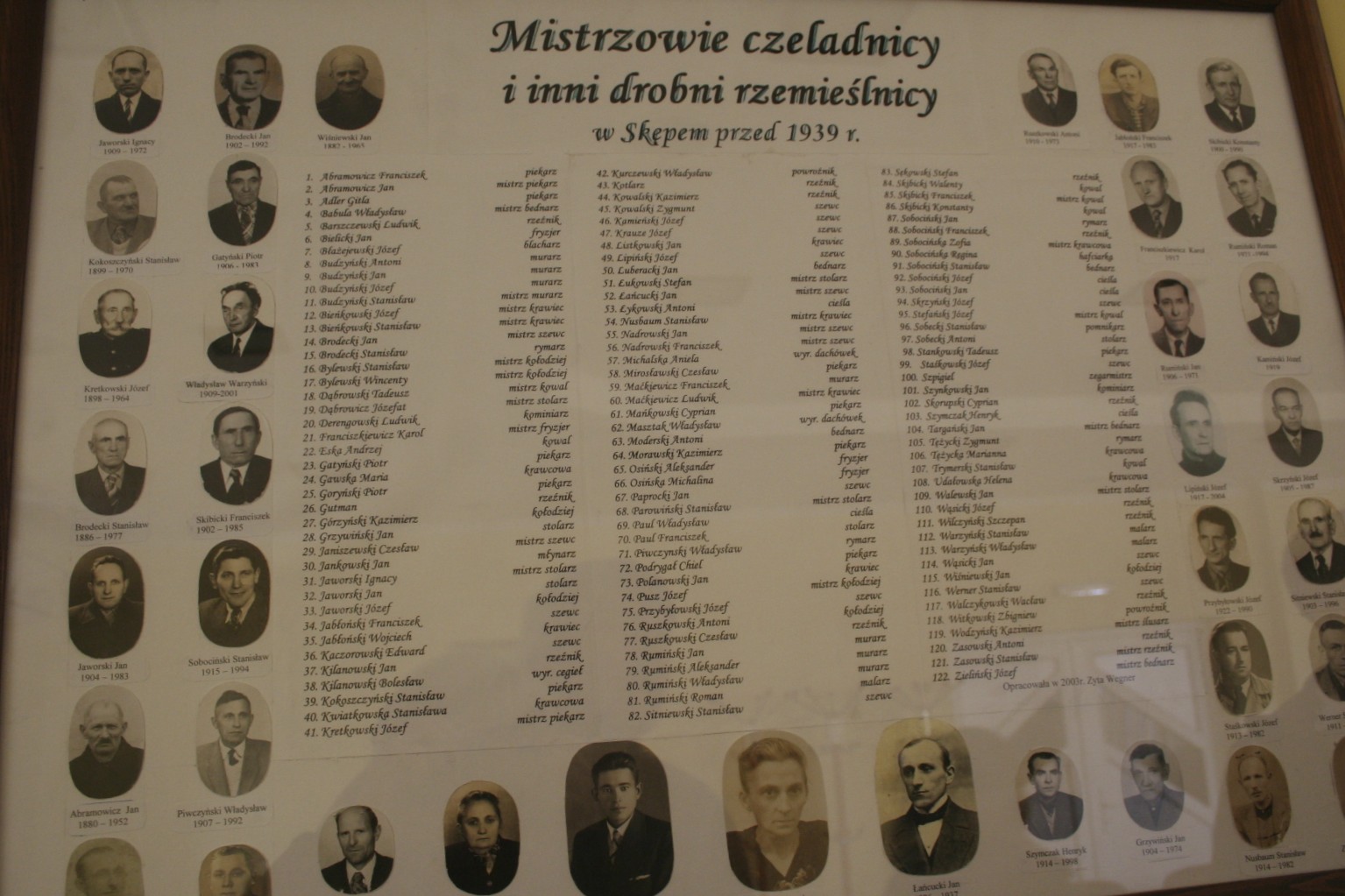 |
|
Master and apprentices and other small craftsman
before 1939. This photo now hangs in a meeting
room in City Hall. It was rescued from a local
attic by Zyta Wegner. There are three Jewish
businesses listed: #3 Adler, Gitla--
baker, #26 Gutman--butcher and #72 Podrygal, Chiel--- baker Photo by Roberta Fleishman |
Rabbi Gelernter of Skępe: Religious
Response to German Invasion of 1939
Part of a sixty-four
page Yiddish document in the Ringelblum archives, a
…..
contemporaneous eye witness report….. copied by a single writer, describes the early September 1939 flight of Jews from Skempa (Skepe) Poland from advancing German troops under the guidance of Rabbi Yosef Gelernter (later a member of Warsaw’s Central Refugee Committee). He told his congregants that their flight pointed to Israel’s mission for the sake of monotheism and morality, even amidst suffering (Citing R. Akiva, Berakhot 61b), in the face of eternal hatred (“Sinat olam le’am olam.” Source?). Thus it was with the Jews of the Crusades and the Inquisition. The response had to be the prayer: Shema Yisrael: Hear O Israel, the Lord our God, the Lord is One (“dos tragish Lebn fun unsere Eltern di Kadoshim fun yener Tsayt, ot in azelkhe bitere Shmertsen hobn unzere Eltern oysgehoykht zayre haylike Neshamot mit di letste verter oyf zayner Lipn: Shema Yisrael Hashem Elokeinu Hashem ehad”). Gelernter assured his congregants that God would not cast them away or break their covenant and would even return them to their border (Leviticus 26:44; Jeremiah 31:16). His group reached
the General Government border town of
Dobrzyn-Wista (sic Dobrzyn nad Wisla) on 8
September, Erev Shabbat, not knowing whether to
continue. Invoking the precedent of Joshua’s plea
for Sabbath’s onset to wait until he could
conclude his battle victoriously (Citing
Pirkei Derabi Eliezer ch. 52 to Joshua 10:12), Gelernter asked them to stop for the Sabbath— making a miracle possible. They stayed in place and on Selihot (10 September, Sunday AM) they prayed, saying over and over again with special emphasis: The soul is Yours [God]. The body is Your work. Have mercy on Your people (Amalekhah) [i.e., in history], O have mercy on Your people. (‘Lekhah yom….’ Selihot Lekhal Yom). Throughout this episode, the God of prayer remained the God of metahistory. …….Reports about the Yamim Noraim, which coincided with or immediately followed upon the invasions, indicate that the relationship remained intact, and consciously so. The Skempa Jews praying on the first day of Rosh Hashanah in Dobrzyn-Wista, according to the contemporary account, pleaded (apparently during Tashlikh) “Out of the depths I cry to Thee, O Lord! Lord, hear my voice! Let Thine ears be attentive to the voice of my supplication” (Psalms 130:2), with such fervor that the report said the plea ascended in ecstasy through the gates of Rahamim up to the throne of glory—even as those standing watch urged them to lower their voices. On the second day of Rosh Hashanah Gelernter recognized that in fact, all mankind was passing before God like a flock of sheep to be judged for slaughter—evoking in his mind the rabbinic interpretation of Leviticus 27:32, where each tenth lamb was sacrificed, and sanctified (“Vekhal ma’aser bakai vatson, kal asher ya’avor tahat hashevet ha’asiri yehiyeh kadosh La’adonai”): Lambs gathered at the door of their shed to be close to their mothers, who waiting desperately at the other side to find out which of their children would be marked red—for sacrifice. (Bekhorot 58b. See Rambam, Hilkhot Bekhorot 7:11). On Yom Kippur (23 September), back in Skempa, fearing that his congregants would be taken to forced labor like the Jews of Lipno and their rabbi Shmuel Halevi Brot, he invoked the High Priest’s plea “may your homes not become your graves” (“Ve’al anshei sharon Hashem Yerahem yehi ratson shelo ya’asu bateihem kivreihem.” See Ta’anit 22b) and the congregants prayed to God desperately during the closing services (Neilah) to open up His gates of Rahamim to them (Ringelblum). That is, the metahistorical stream continued, the mythic language of God’s actions fit together with the empirical realities of the present. Jewish Religious Practice Through the War: God, Israel and History by Gershon Greenberg 4 April 2001 Yad Vashem, Jerusalem |
The Jewish Cemetery of Skępe
| The Jewish Cemetery
in Skępe, Poland dates back to just before 1850
(Virtual Shtetl). A cousin from Toronto had
visited the cemetery 20 years earlier, but only
after he located an older resident who knew where to
find it. Our cousin encouraged us to locate
and visit the cemetery. Thanks to a local town historian, Zyta Wegner and her husband Bernard, we were able to locate and visit what is left of the old Jewish Cemetery. To get there one leaves the town square on Rynek (the location of many Jewish businesses before 1939) and take Dobryzyńska street traveling southwest out of Skępe. After crossing a small creek you bear right on Rybacka and pass a couple of homes on the right. After the last home you enter an area of woods and come across a small, dirt road on the right which enters the woods and quickly descends to another dirt road (Aleja Spacerowa) which hugs the southern shore of Jezioro Małe, which the cemetery overlooks from its hillock location. One can park your car at the intersection of the dirt access road from Rybacka and Aleja Spacerowa, find the path to the left, and follow it up the hillock. After a short distance you will find a small foundation - the only remnant of what was once the resting place of Skępe’s Jews. Except for a few depressions in the soil there are no other indications that this was sacred ground: no matzevot remain to indicate the location of one’s family members. However, the foundation to a small building sits atop the hillock in a prominent position looking out over the lake (Jezioro Małe). At the time of our visit we wondered if it had once been used to prepare a body for burial. A follow up interview with an older, former resident, Stanisława Nadrowska of Skępe in late May, changed our understanding. According to her the building was a monument (Ohel) to a prominent Jew of Skępe - probably a rabbi. Standing by the ohel foundation, shaded by large trees and a picturesque view of Skępe, our guide, Bernard Wegner, pointed to another hillock immediately to the northeast and informed us this was the original Jewish Cemetery from the 1800’s. After it was filled, the Jewish community purchased additional land to accommodate future burials. Skępe has a similar history with many other Polish towns. Even though it is reported the Germans destroyed the cemetery after 1939, it was local townspeople who collected the matzevot for use in their foundations, sidewalks, and steps. Until a short time ago the path leading from a home on Rybacka down to the lake had steps made from the matzevot of the cemetery. These cemetery markers recently disappeared and their whereabouts are unknown. |
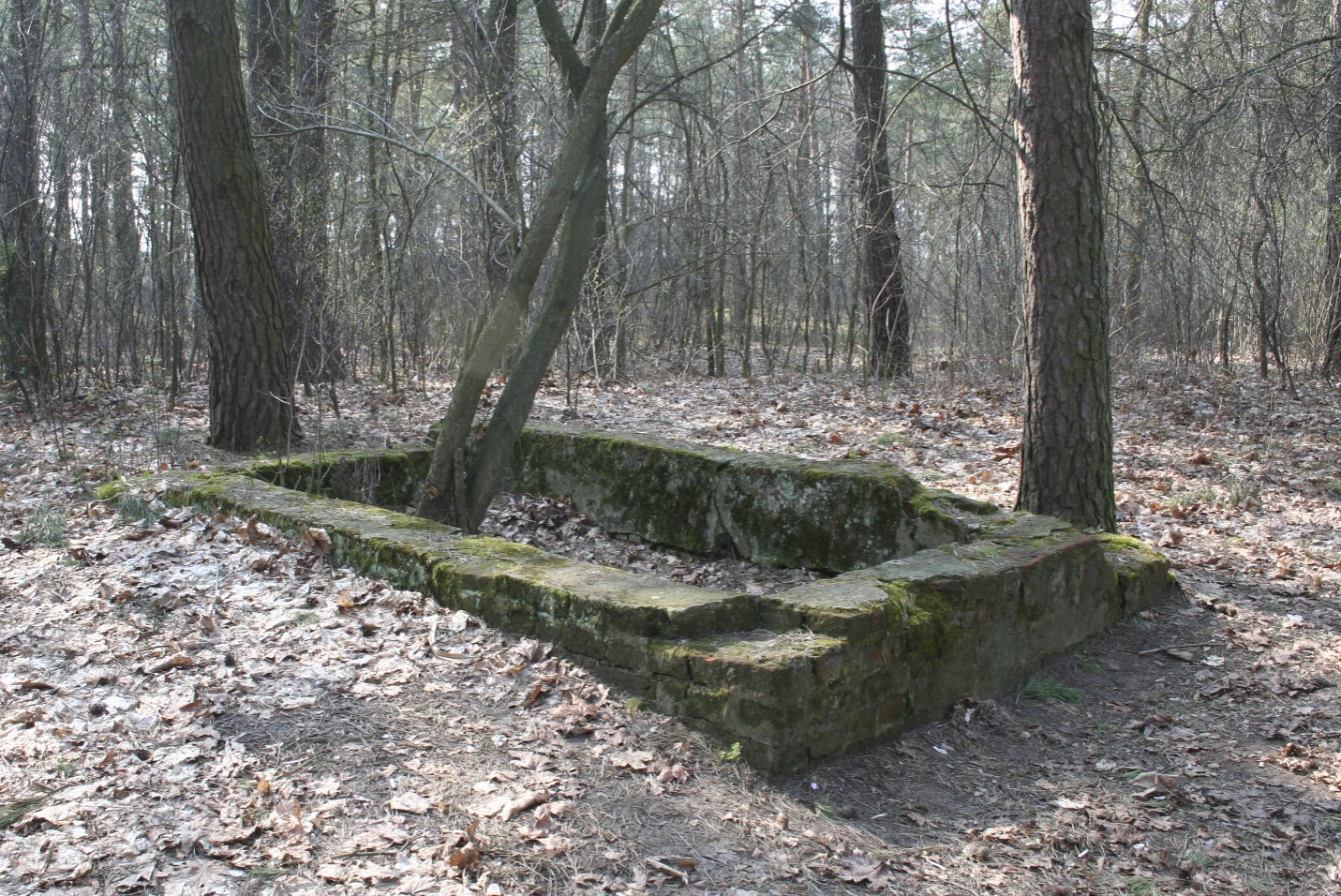 |
|
| The
path alongside the cemetery in Skępe |
The
remains of an ohel in the cemetery |
| A
view of Skępe from the cemetery |
More
of the cemetery from the ohel |
| The
oldest part of the Jewish Cemetery Cemetery Photos
by Roberta Fleishman
|
Matzevot
had been used as steps between the lake and this home
but were recently removed |

Compiled by Roberta Fleishman and Mike Smith
roberta.fleishman@gmail.com
Copyright © 2013 Roberta Ann Fleishman
roberta.fleishman@gmail.com
Copyright © 2013 Roberta Ann Fleishman
This site is hosted at no cost by JewishGen, Inc., The home of Jewish Genealogy. If you have been aided in your research by this site and wish to further our mission of preserving our history for future generations, your JewishGen-erosity is greatly appreciated.
